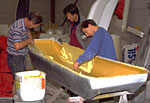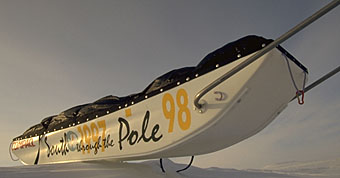|


|

|
Sledges
As was the case during the North to the Pole 1994 expedition, the
two sledges have been completely designed and produced for the expedition
by Famenne-Plastics, a small company in Verdenne, in conjunction
with the civil engineering laboratories at the UCL (Catholic University
of Louvain-la-Neuve). Carrying out the tests (fatigue from pulling,
flexing, elasticity module, etc.) on different types of prototype
made it possible to identify the material required for the sledges
and then to select what was best suited to the conditions required
by the expedition.
 The ideal number of layers of Kevlar needed to build the sledges
was worked out with the help of a digital model using the finished
elements and examining them in terms of different loads and supports.
Pulling the sledges is done with a removable shaft made from titanium
tubes which pivot on an axle running across the front of the sledge.
On difficult terrain (such as a crevasse field), two ropes can replace
the shafts to give the sledge more maneuverability.
The ideal number of layers of Kevlar needed to build the sledges
was worked out with the help of a digital model using the finished
elements and examining them in terms of different loads and supports.
Pulling the sledges is done with a removable shaft made from titanium
tubes which pivot on an axle running across the front of the sledge.
On difficult terrain (such as a crevasse field), two ropes can replace
the shafts to give the sledge more maneuverability.
The runners are made from high-density polyethylene; they slide
around a rail riveted to the body of the sledge in order to allow
for dilation and ensure the best possible glide.
The sledges used in this expedition are different from the ones
used at the North Pole in these ways:
- They are not amphibious.
- They are lighter and longer (2.50/70 m instead of 2.40/50
m).
- These new runners have better glide.
- They are wider in order to give them greater lateral stability
when running with parafoils.

|

